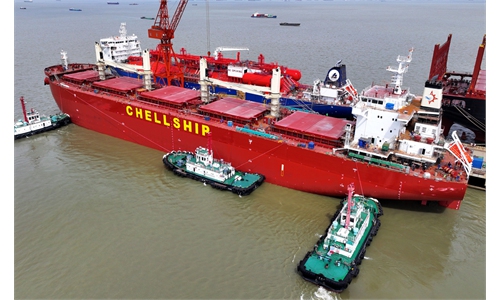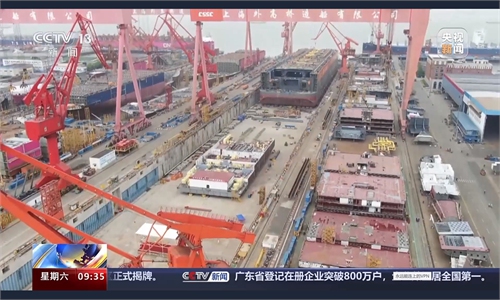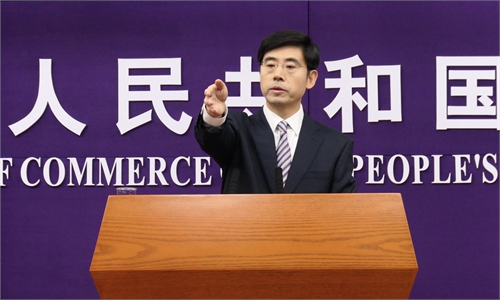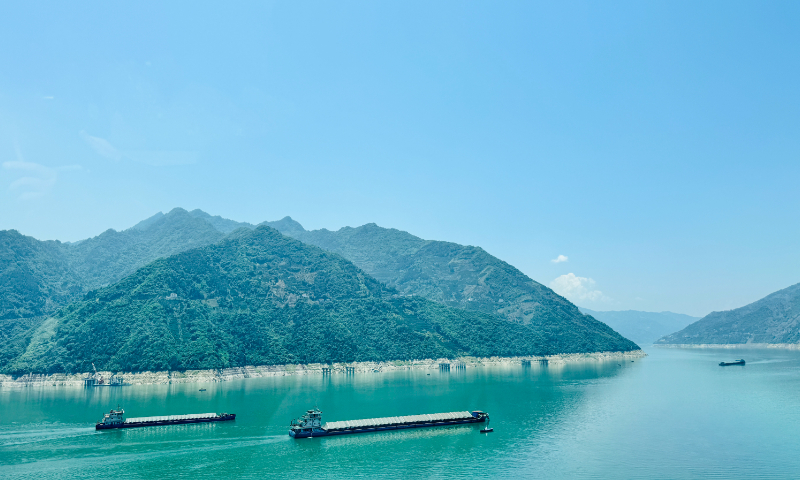
Ships sail in the Yangtze River in Zigui, Central China's Hubei Province, on May 23, 2024. Photo: Chi Jingyi/GT
Editor's Note:
As the Chinese economy faced some challenges in recent years, some Western officials and media pundits have stepped up their smear campaign against China. They cherry-pick information and distort facts to hype their narratives such as "Peak China," but they always turn a blind eye to China's economic resilience and development potential. In order to set the record straight, the Global Times is launching a multimedia project, including in-depth articles, objective analysis and visual arts, to present a comprehensive and true picture of the economy. This is the sixth installation of the series.
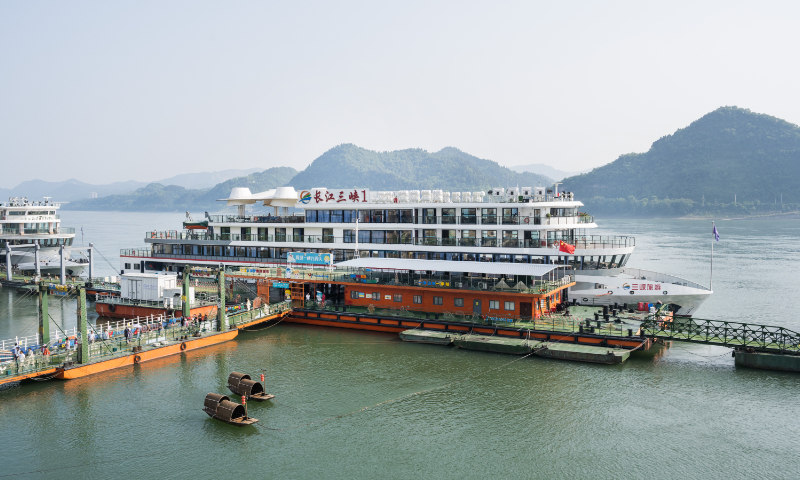
Tourists disembark from the Yangtze River Three Gorges 1, the world's largest pure electric cruise ship, at a wharf in Yichang, Central China's Hubei Province, on May 23, 2024. Photo: Chen Tao/GT
During a routine work day, hundreds of tourists disembarked from theYangtze River Three Gorges 1,the world's largest pure electric cruise ship, at a wharf in Yichang, Central China's Hubei Province.
The ship has made touring the Yangtze River a quiet journey and without the smell of diesel. The electric ship is charged at the wharf overnight, with electricity generated from the Three Gorges Dam.
The construction of the ship has been hard work and represents a breakthrough using a number of novel advanced technologies. The success of building a purely electric ship has set a new landmark, meaning that the shipbuilding industry of China is becoming greener and smarter too, the Global Times learned.
"I am amazed when I stood on the deck while the ship is sailing at a high speed. This is something I did not dare to think before, but today it has become true," Ye Yong, general manager of the Tourism Development Division at the Three Gorges Tourism Group under Yichang City Development Group, told the Global Times.
The Three Gorges Tourism Group is a joint developer ofYangtze River Three Gorges 1and is now the operator of the ship.
The operational range of the ship surpasses 100 kilometers after being charged for 6-8 hours, reducing about 40 percent of previous operating costs. The ship has realized zero emissions.
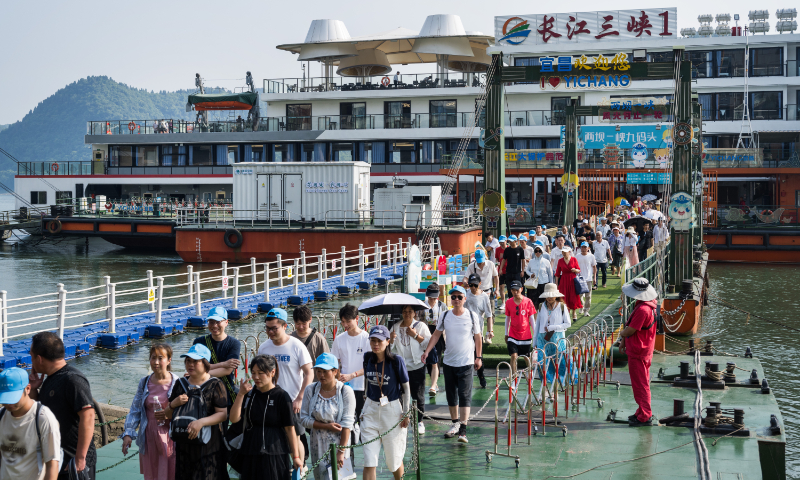
Tourists disembark from the Yangtze River Three Gorges 1, the world's largest pure electric cruise ship, at a wharf in Yichang, Central China's Hubei Province, on May 23, 2024. Photo: Chen Tao/GT
"How can you imagine that such a massive ship is powered by several power batteries? The total battery capacity of the ship is equivalent to that of more than 100 electric vehicles," Ye said.
Inside the main cabin of theYangtze River Three Gorges 1,the Global Times observed four battery compartments, carrying a total of 720 lithium-ion phosphate battery packs, with a battery system of 7,500 kilowatt-hours.
Complete industrial chain
The construction of theYangtze River Three Gorges 1has boosted the development of China's shipbuilding industry, from design to materials, from technologies to standards, a manager of Yichang Xinhui Ship Repair and Building Co told the Global Times.
The company was acquired by the Three Gorges Tourism Group to build the electric ship.
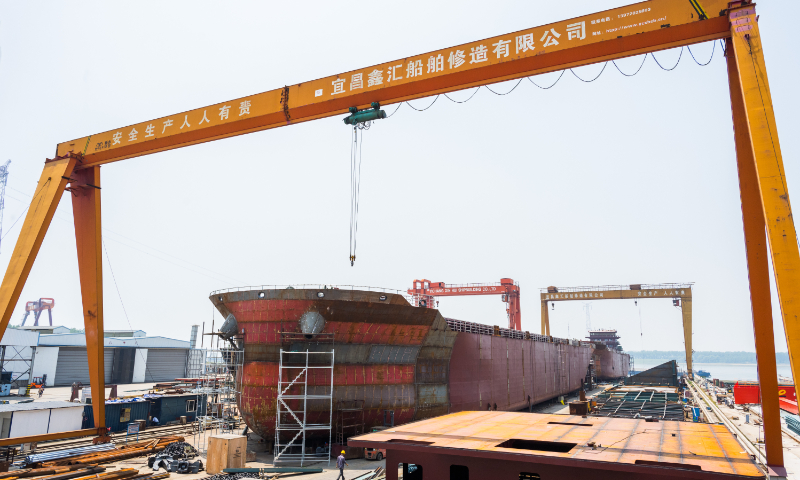
Photo taken on May 24, 2024 shows a shipbuilding platform of Yichang Xinhui Ship Repair and Building Co in Zhi gian g, Central China's Hubei Province.X Photo: Chen Tao/GT
"So far, we have orders for 28 ships, with a value of about 1 billion yuan ($138 million). We are rushing to make two orders of new-energy passenger ships," said the manager.
The company has accelerated cooperation with research institutes, jointly developing new technologies and new processes in the fields of new energy, composite materials and anti-corrosion coating, so as to build a construction base for new-energy ships.
Yichang Xinhui Ship Repair and Building Co is among the nine shipbuilding enterprises located in the Yichang Shipbuilding Industrial Park in the nearby Zhi gian g city, which is under the jurisdiction of Yichang.
Welding sparks flickered on the shipbuilding platforms, and several 10,000-ton giant ships are being built in the park. By the Yangtze River, four 5,000-ton standard bulk carriers were close to being delivered, and in the workshops, eight methanol dual-fuel multi-purpose ships were under construction, the Global Times learned.
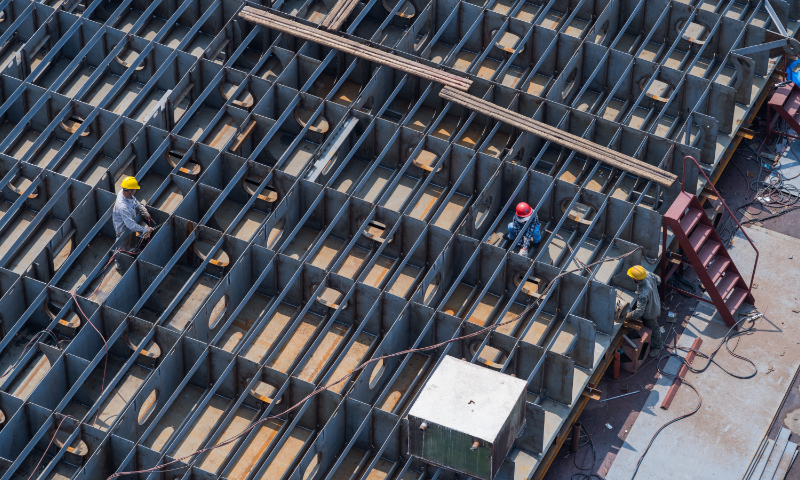
Photo taken on May 24, 2024 shows a shipbuilding platform of Yichang Xinhui Ship Repair and Building Co in Zhi gian g, Central China's Hubei Province.X Photo: Chen Tao/GT
At present, the industrial park has established a green intelligent ship industrial chain, integrating research and development, design, construction, operation and management.
In 2023, a total of 73 ships have been built while 72 ships were under construction by the nine shipbuilding enterprises in the industrial park, an increase of 11 percent year-on-year. New-energy ships accounted for nearly 30 percent of total output.
So far in 2024, there are 38 ships under construction in the industrial park, with 41 percent being new-energy ships. The annual output value of shipbuilding is worth about 6 billion yuan.
In Yichang's Zigui county, which is about 120 kilometers away from Zhi gian g, robotic arms are producing batteries for ships at a smart workshop in Zigui Green Intelligent Ship Industrial Park.
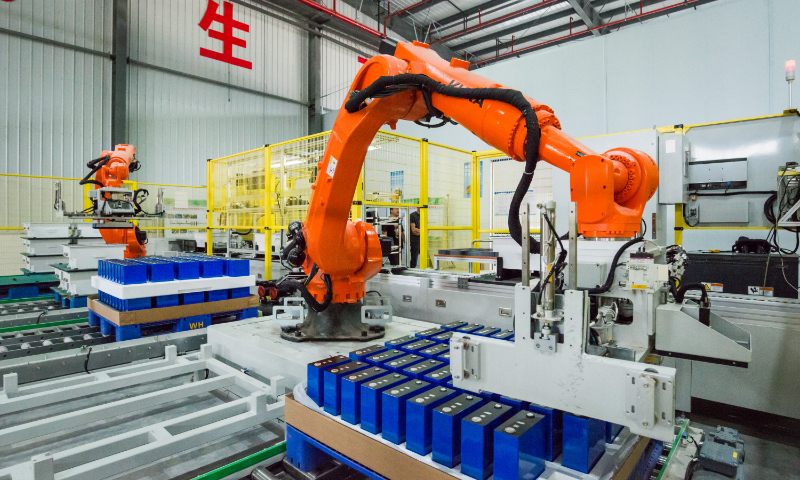
Robotic arms produce battery packs for ships at Zigui Green Intelligent Ship Industrial Park in Zigui, Central China's Hubei Province, on May 22, 2024. Photo: Chen Tao/GT
The production line is more than 50 meters long, including 19 assembly and test stations, with 19 robotic arms completing the work from battery installation to detection, and the automation rate hits more than 80 percent, a representative surnamed Zhou from a battery production enterprise at the Zigui Green Intelligent Ship Industrial Park told the Global Times.
"At present, with a daily output of 400 kWh, the annual output is expected to be 200 million yuan," said Zhou.
Zhou explained that the battery pack is designed with self-developed technologies, such as thermal runaway blocking, high efficiency thermal conductivity, cell heat insulation and oxygen insulation. The technologies ensure that the battery packs are safe and highly efficient, and ensure that the battery does not catch fire or explode under extreme conditions like overcharge, short circuit, or external combustion.
It is expected that by the end of 2026, the total output value of the green ship manufacturing industry chain in Yichang will reach 50 billion yuan. The city will build 2-3 industrial parks, and the annual construction of green intelligent ships will exceed 300.
"When you buy an electric car, you need to consider how to charge it. It is the same with electric ships. Fortunately, Yichang has built a complete onshore charging system to ensure the operation of electric ships," said Ye.
Supporting facilities
At present, 37 tourist cruises operating within the tourist area of the Three Gorges Dam have completed construction of power transformation interfaces, which can be connected directly with the onshore power grid, a manager surnamed Li from Yichang Power Supply Co, a subsidiary of State Grid Hubei Electric Power Co, told the Global Times.
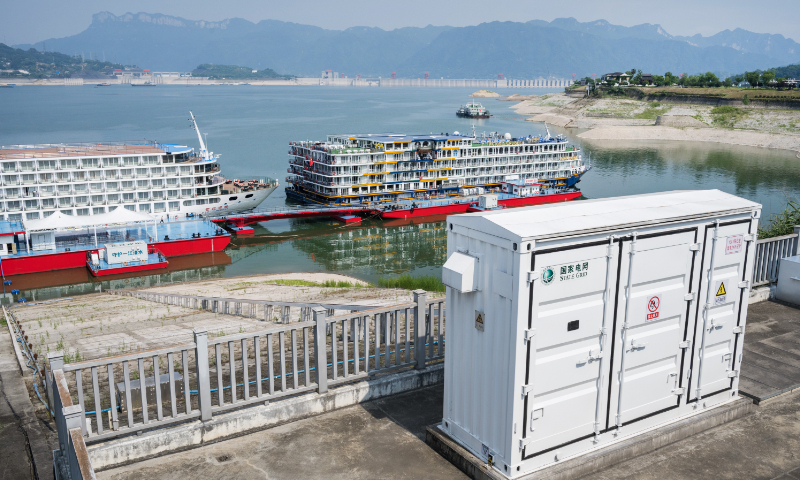
Cruises are being charged with electricity from onshore power equipment along the Yangtze River in Zigui, Central China's Hubei Province, on May 22, 2024. Photo: Chen Tao/GT
In April, 2015, the first batch of onshore power equipment along the Yangtze River was settled in Zigui, with a total of three power distribution platform areas and 20 self-service power boxes installed, which can charge 80 ships at the same time, said Li.
By the end of 2020, the Yichang section of the Yangtze River was fully covered by onshore power equipment.
At present, 171 sets of onshore power piles have been built in 70 piers and anchorages along the Yangtze River in Yichang, which provided 12.16 million kWh of electricity for 15,799 passenger and cargo ships in 2023, equivalent to the reduction of 2,858 tons of fuel and 9,001 tons of various gas emissions, Li said.
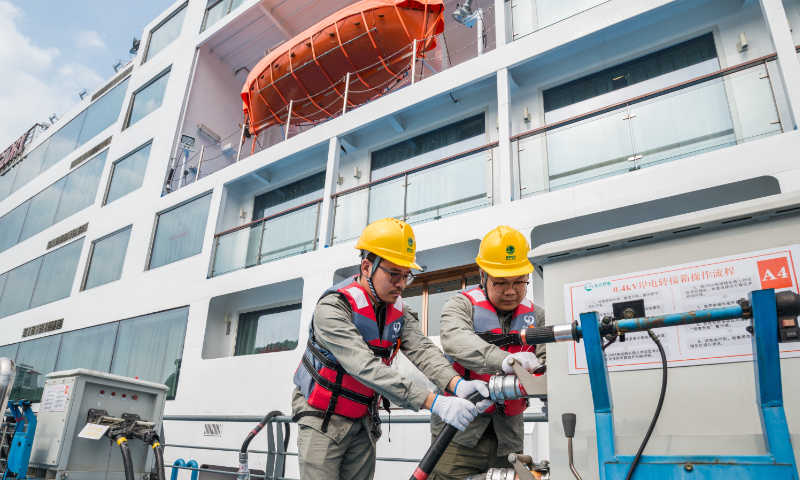
Workers charge a cruise using electricity from onshore power equipment along the Yangtze River in Zigui, Central China's Hubei Province, on May 22, 2024. Photo: Chen Tao/GT
The complete industrial chains, advanced technologies and supporting facilities will continue to boost China's shipbuilding industry, which has maintained a leading position in the world.
In the first quarter of 2024, the three major indicators of China's shipbuilding industry - the number of completed ships, orders on hand and new orders - all increased.
During the same period, China's shipbuilding industry accounted for a large share of the global total, with output accounting for 53.8 percent, new orders accounting for 69.6 percent and existing orders accounting for 56.7 percent, according to statistics released by the China Association of the National Shipbuilding Industry in May.
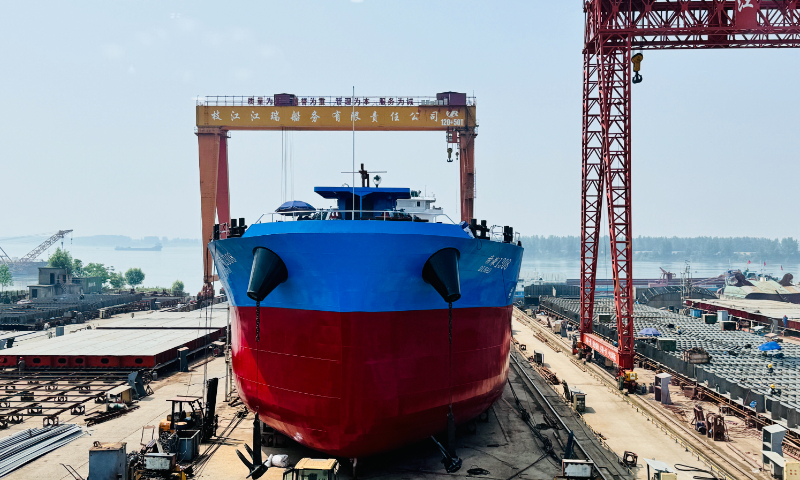
A ship is being built at the Yichang Shipbuilding Industrial Park in Zhi gian g, Central China's Hubei Province, on May 24, 2024. Photo: Chi Jingyi/GT
China has pushed to integrate advanced technology into shipbuilding, achieving an integration benchmark against international standards, industry insiders said, addingthat China is currently leading in competitiveness in ship production, maintenance and services.
China has been leading the world in yearly obtained ship orders for the past three years. Its market share in the global shipbuilding industry rose to 58.9 percent in 2023, up from around 50 percent in 2022, according to the Clarkson Research, a UK marine industry tracking institute.
